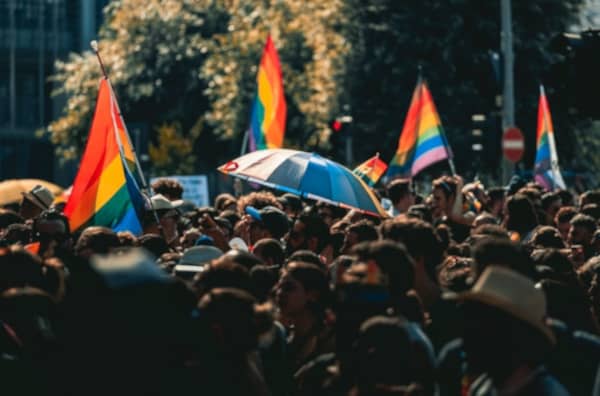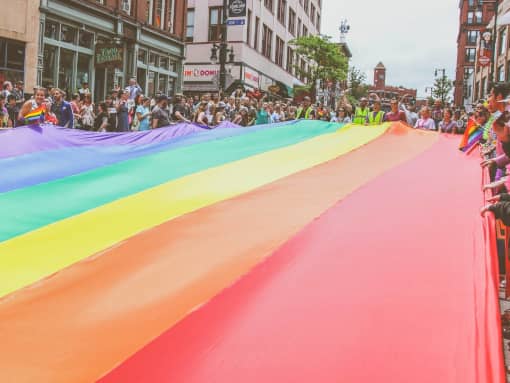Digital Pride 2020. The Future or a Flop?
Pride organisers have had to innovate. What does this mean for Pride and LGBTQ+ mental health?
Digital Pride 2020. The Future or a Flop?
As we come to the end of Pride season for another year it is fair to say that it was unlike any other. Covid-19, social distancing, travel bans and police fines all risked putting a serious limit on celebrations. Across the world ‘Plan B’ was rolled out. We reflect on the meaning of Pride in 2020, how was affected by the move to ‘Digital Pride’ and the impacts on mental health.
The need for Pride?
With major gatherings suddenly a great risk for Covid-19 transmission, over 500 were rapidly cancelled or postponed in the summer of 2020[1]. Pride organisers faced a stark question: should they still hold an event at all?
Although unavoidable, these cancellations created a missed opportunity for many who may be struggling with their mental health. Research identifies a clear link between the LGBTQ+/GSRD (gender, sexuality and relationship diversity) community and higher rates of poor mental health and lower wellbeing[2]. Suppression of the true self, lacking a sense of belonging or community, fear of disclosure and discrimination are all contributing factors to this, and often, Pride can assist[3]. Could a move to a virtual pride replace face to face interaction and the benefits that ‘traditional’ Pride can bring?
Before we look at the impact of going digital, let’s take a moment to look at what Pride really is and why it’s important. As we become more and familiar with the annual event, it can be tempting to see it as ‘just’ a big party but there is real importance and meaning to the event.
At its heart, Pride exists to challenge the negative images, messages, ideas, press, abuse and violence that LGBTQ+/GSRD people have, and continue to experience, as part of a minority, historically marginalised and often stigmatised group. Brighton & Hove Pride organisers sum this up well (and they would know, they attract around 450,000 visitors each year)[4]:
“Pride takes place to recognise and celebrate the LGBTQ+ history and the progress made towards equality. Pride is also a protest as people stand up against the continued injustices that LGBTQ+ people face in the world, and show solidarity.”[5]
What would a discussion of Pride be if we also didn’t reference Stonewall and the birth of Pride itself? The annual Pride march is a moment to commemorate the riots and protests which followed the 1969 Stonewall Inn police raids in New York. These demonstrations, led mainly by trans women of colour[6], were a community response to persistent pressure and abuse towards LGBTQ+ individuals and venues[7] with the first UK Pride held in London in 1972[8]. It continued (and still continues) to grow across the world since the initial riot and commemoration parade the year after. The history of Stonewall is topic all of its own but for now, it’s important to remember the emotive and important roots of today’s Pride ‘celebrations’.
While society’s acceptance of the LGBTQ+/GSRD community has improved since those first 1969 riots, the community still experiences discrimination and marginalisation. The examples are endless but one poignant case is the violence directed at transgender women, particularly those who are Black. This community is at significantly greater risk of violence and fatal violence than many other communities[9]. On the International Transgender Day of Remembrance, the names of those murdered in the previous 12 months are read aloud (331 known cases 2018-19)[10]. This moving experience certainly paints Pride with a new focus and is framed by an 81% increase in transphobic violence in 2019 in the UK[11]. In fact, it is so prolific that the Human Rights Campaign describe it as a national crisis in the USA[12].

LGBTQ+ and GSRD communities are given a safe space through Pride. The scale of the events can help to turn isolation into genuine community and allyship (for those able to attend).
Digital Pride. Did it work?
2019 was the 50th anniversary of the Stonewall riots. Reports differ but somewhere up to 5 million[13] people attended the celebration in NYC. The contrast between the 2019 and 2020 events could not be starker. Pride organisers across the world had to quickly work out how to hold Pride when gatherings were banned. But what about the impact for the people who attend them? Or for those who it is the one day or weekend of the year they feel able to truly or fully express themselves?[14]
Hopes were high for alternative Pride events. Ultimately, many of the larger events chose to use a mixture of old and new footage and stream virtual Pride events via YouTube.
One significant benefit of this was visibility (both in terms of community support and community celebration). The hope was that holding Pride celebrations online could reduce isolation (which may be even more prevalent due to lockdowns) as well as improve visibility[15]. Free platforms such as YouTube meant that events could be watched from home in any number of countries.
The problem was, though, that they weren’t. Well not really anyway.
Despite the valiant efforts of organisers, spontaneous digital community is extremely difficult to achieve. Some events drew in digital crowds. Global Pride was a standout success attracting 57 million viewers[16]. Most however, were less fortunate. Brighton’s half a million attendees in 2018 contrasted with 30,000 views (at the time of writing this) for its top 2020 video[17]. It would seem therefore that on numbers alone, the outreach of digital Pride is much reduced. Community, without physical proximity, may take years of effort to achieve.
Finally, we should consider the longer-term impact that 2020 online Pride might have for future events. Many Pride groups are charities, relying on the proceeds from the previous event to fund the next. Donations by attendees, ticket sales, food and drink sales and sponsorships mostly require in person events. Lower viewing numbers may also truly test the commitment of some sponsors. Hopefully the fundraising of the online events has been successful enough to safeguard Pride in the future but it is too soon to tell.
Interested in knowing more?
Here at the School of Applied Mental Health we are focused on ensuring that professionals are trained to work with the complexities of modern society, reflecting the lives of those we are here to help. For more mental health information, check out the rest of our blog.
Custom CSS Box
Your content goes here. Edit or remove this text inline or in the module Content settings. You can also style every aspect of this content in the module Design settings and even apply custom CSS to this text in the module Advanced settings.
How to Reference this Blog Post
Suggested reference for this post:
School of Applied Mental Health (2020). Digital Pride 2020. The Future or a Flop? Available from: https://www.schoolofappliedmentalhealth.com/digital-pride-2020
References
[1] European Pride Organisers Association (2020). Coronavirus/Covid-19. Available from: http://epoa.eu/coronavirus/
[2] Semlyen, J., King. M., Varney, J., and Hagger-Johnson. G. (2016). Sexual Orientation and Symptoms of Common Mental Disorder or Low Wellbeing: Combined Meta-Analysis of 12 UK Population Health Surveys. BMC Psychiatry, 16, 67. Available from: https://bmcpsychiatry.biomedcentral.com/articles/10.1186/s12888-016-0767-z
[3] Semlyen, J. (2019). LGBT+ Mental Health: Understanding Disparities and Meeting Mental Health Needs. Available from: https://www.researchgate.net/publication/335054585_LGBT_Mental_Health_Understanding_disparities_and_meeting_mental_health_needs
[4] Razavi, A. (2018). Brighton Pride 2018 was the Biggest One Yet. Available from: https://www.theargus.co.uk/news/16401494.brighton-pride-2018-biggest-one-yet/
[5] Brighton and Hove City Council (2020). Pride Events are Cancelled – Celebrate Online. Available from: https://new.brighton-hove.gov.uk/news/2020/pride-events-are-cancelled-celebrate-online
[6] Lorenzo, I. (2019). The Stonewall Uprising: 50 years of LGBT History. Available from: https://www.stonewall.org.uk/about-us/news/stonewall-uprising-50-years-lgbt-history
[7] Lorenzo, I. (2019). The Stonewall Uprising: 50 years of LGBT History. Available from: https://www.stonewall.org.uk/about-us/news/stonewall-uprising-50-years-lgbt-history
[8] Lorenzo, I. (2019). The Stonewall Uprising: 50 years of LGBT History. Available from: https://www.stonewall.org.uk/about-us/news/stonewall-uprising-50-years-lgbt-history
[9] Human Rights Campaign (2019). Violence Against the Transgender Community in 2019. Available from: https://www.hrc.org/resources/violence-against-the-transgender-community-in-2019
[10] TDoR (2019). Trans Day of Remembrance 20.11.2019. Available from: https://tdor.tgeu.org
[11] BBC News (2019). Transgender Hate Crime Recorded by Police Go Up 81%. Available from: https://www.bbc.co.uk/news/uk-48756370
[12] Human Rights Campaign (2015). A National Crisis: Anti-Transgender Violence. Available from: https://www.hrc.org/resources/a-national-crisis-anti-transgender-violence
[13] Fitzsimons, T. (2020). LGBTQ Activists Join Forces to Reimagine Pride Amid Coronavirus Pandemic. Available from: https://www.nbcnews.com/feature/nbc-out/lgbtq-activists-join-forces-reimagine-pride-amid-coronavirus-pandemic-n1190651
[14] McGonagle, E. (2020). Going Digital Could Help Pride Reach New Audiences. Available from: https://www.campaignlive.co.uk/article/going-digital-help-pride-reach-new-audiences/1685926
[15] Haynes, S. (2020). ‘There’s Always a Rainbow After the Rain.’ Challenged by Coronavirus, LGBTQ Communities Worldwide Plan Digital Pride Celebrations. Available from: https://time.com/5814554/coronavirus-lgbtq-community-pride/
[16] Global Pride (2020). Thank You. Available from: https://www.globalpride2020.org
[17] Pride TV Network (2020). Brighton Pride FRIDAY: We are FABULOSO – Warm Up Show. YouTube [online]. Available from: https://www.youtube.com/watch?v=QiGzUEnmYaA

